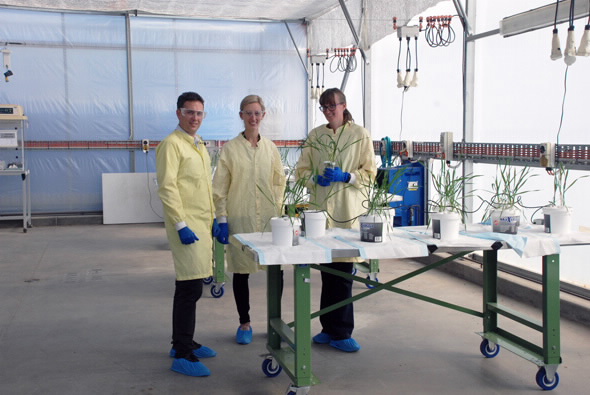
Researchers from the Future Industries Institute at the University of South Australia are collaborating with a group of scientists at ANSTO to investigate a new class of micro and nano-scale zinc fertilisers for broadacre crops, such as wheat.
Zinc is an essential micronutrient required for the growth of wheat with crucial roles throughout the plant. Australian agricultural soils are known to be deficient in zinc and other micronutrients.
Dr Casey Doolette (pictured above centre) and PhD candidate Thea Lund Read (pictured above right) from Prof Enzo Lombi’s lab are assessing if nano and micro zinc particles applied to leaves (known as foliar fertilisers) provide a more sustained supply of zinc to crops than dissolved forms of the metal.
They are also evaluating two commonly used agricultural formulations, soluble zinc and chelated zinc (Zn-EDTA).
In order to make this evaluation, they needed to use a combination of tools to understand zinc transport and bioaccumulation.
One technique, based on the use of radiotracers to track the distribution of elements, was of particular interest and available at ANSTO.
ANSTO Environmental Research scientist Dr Tom Cresswell (pictured above left) has expertise in the use of radioactive isotopes as tracers in marine organisms to study the bioaccumulation of specific elements.
“It is slightly different working with plants but the concept is essentially the same. By using zinc-65 as a radiotracer, it is possible to detect exactly where the zinc goes after it has been absorbed by the plant,” said Cresswell.
ANSTO Biologist Nicholas Howell has captured a series of autoradiographic images of the plants that show the change in distribution of radioactive zinc, in live leaves, over time.
“Conventional analysis and imaging of zinc is limited because the naturally-occurring zinc in the leaves makes it difficult to identify newly-accumulated zinc,” Said Doolette.
The purpose of the study is to determine what form of zinc is the most efficient for supplying the nutrient to broadacre crops following its application to the leaves.
Doolette explained that although zinc can also be delivered directly to the soil, there are some limitations due to soil conditions that affect its ability to address zinc deficiency in plants. “When you deliver zinc to Australian agricultural soils, the zinc tends to get locked up, particularly in alkaline soils, and is not readily available to the plants,” said Doolette.
 |
This occurs because zinc is largely immobile in soil and only moves short distances from the point of placement.
Leaf applications of zinc are used by crop farmers to supplement soil applications.
Doolette explained that applying zinc in a soluble formulation has a tendency to damage the leaves.
“However, if the zinc can be released slowly into the leaf, such as the case when it is applied in nano form, there is likely to be less leaf scorch” said Doolette.
The investigators are not focused on how the zinc, in the form of soluble zinc, is taken up but rather how much zinc is bioaccumulated.
They are measuring zinc concentrations, as well as identifying where the zinc is transported in the plant, whether it be the new shoots, stems or grains.
“Ideally we would hope to have the applied zinc accumulate in the grains of the plant, where it has the most nutritional benefit as food, which is known as biofortification,” said Doolette.
“We hope to find out if using zinc nanoparticles is a viable way of administering it as a nutrient.”
Doolette and Read transported 140 wheat plants by air to ANSTO, where they were housed in a greenhouse on-site fully licenced for conducting radiotracing studies.
Plants were harvested, or imaged, after one day, 14 days and at maturity (i.e. the production of grains) to evaluate the translocation and biodistribution of zinc.
The imaging technique developed by the team has allowed for single plants to be measured at multiple time points without the need to harvest, producing a true, and unique, longitudinal data set.
The concentration of zinc is quantified using gamma spectroscopy.
The zinc particles for the experiments were made industry partner Sonic Essentials and were made radioactive using the OPAL research reactor.
“By determining the most efficient form of zinc for direct foliar application, crop management strategies can be optimised to increase crop yield and quality,” said Doolette.
Zinc is used by the plant for protein metabolism, synthesis of hormones and in the production of essential enzymes.
“We would also be interested in knowing how much zinc is not taken up by the plant, as this zinc would be released into the environment with rainfall,” said Cresswell.
“From the perspective of an ecotoxicologist, it is important to know if the zinc is affecting freshwater runoff.”
Food security, plant nutrition and soil fertility at the Future Industries Institute also collaborates with the School of Agriculture and Food Science at the University of Queensland.
Published: 22/05/2018


